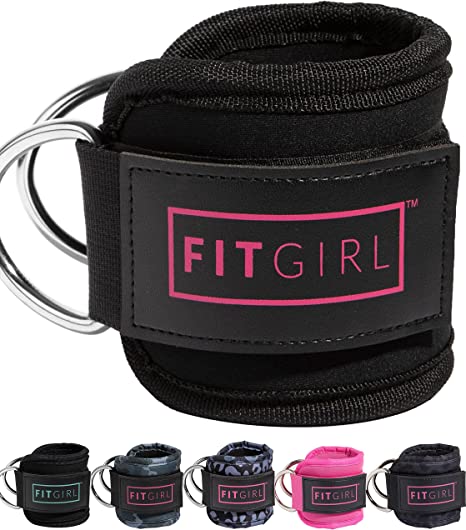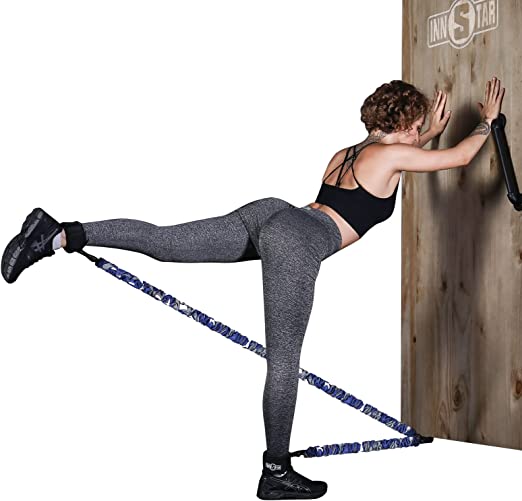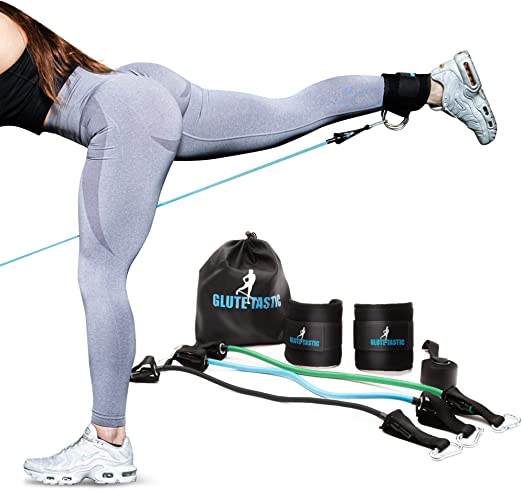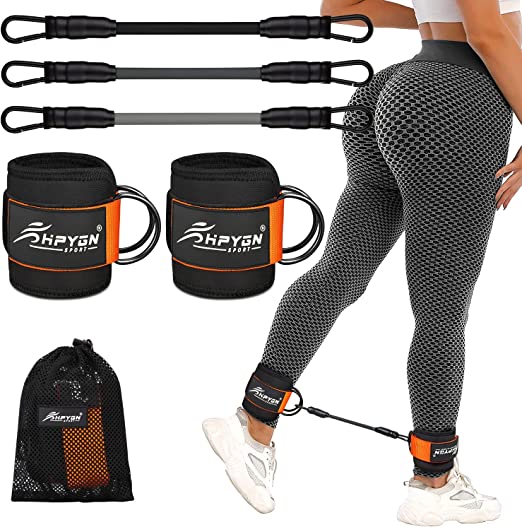The ability of cable kickback exercises to properly target and sculpt the glute muscles has given them increased appeal in recent years. Include cable kickbacks in your training regimen if you want to increase your lower body strength, improve your balance, and avoid injuries. The advantages of cable kickbacks, several exercises you may do, appropriate form and technique, and more will all be covered in this article.
Introduction
A resistance training exercise known as the “cable kickback” focuses largely on the glute muscles, which include the gluteus maximus, hamstrings, and core muscles. It involves the use of a cable machine, which maintains tension throughout the exercise, enabling controlled and precise muscle activation.

DMoose Ankle Strap for Cable Machine Attachments – Rust Resistant Coated Black D Rings Gym Ankle Cuff for Kickbacks, Glute Workouts, Leg Extensions, Curls, Booty Hip Abductors Exercise for Men & Women
Cable Kickback Advantages
Muscle Targeting and Activation
Cable kickbacks are an efficient way to target and work the glute muscles, particularly the gluteus maximus. By concentrating on these muscles, you can get a firmer, rounder rear. Additionally, cable kickbacks work the hamstrings and the core, strengthening and stabilizing the entire lower body.
Enhanced Stability and Balance
When you perform cable kickbacks, you must maintain your stability and balance while working against the cable machine’s resistance. This exercise lowers the risk of falls and injury from daily activities by strengthening the muscles necessary for keeping a stable posture.
Injury Reduction and Prevention
The use of cable kickbacks in injury prevention and recovery is advantageous. You may increase stability and lessen your risk of injuries, especially to the hips, knees, and lower back, by strengthening your glutes and your entire lower body.
Exercises for Cable Kickback
You can integrate a variety of cable kickback variations into your workout program. To get you started, try these three popular exercises:
Standing Cable Kickback
Connect a low cable pulley to an ankle cuff.
Standing with your feet shoulder-width apart, face the cable machine.
Just above the ankle on your working leg, fasten the ankle cuff.
Kick your working leg backward while keeping your knee slightly bent.
Maintain a steady upper body while lifting your working leg as far back as is comfortable.
At the peak of the exercise, take a little pause and contract your glutes.
After the required number of repetitions, slowly return your leg to the starting position.
Repeat the exercise with the other leg after switching sides.
Bent-Over Cable Kickback
The cable machine should be set to the lowest position.
Stand with your feet shoulder-width apart, looking away from the machine.
Keeping your back straight and your core active, bend forward at the waist.
Put the ankle cuff on the leg that will be functioning.
Kick your working leg backward while keeping it parallel to the ground and with a slight bend in the knee.
Aim to contract your glutes at the movement’s peak.
Lower your leg gradually, then repeat for the appropriate amount of times.
Repeat the exercise with the other leg after switching sides.
Lying Cable Kickback
Set the cable machine’s height to the middle position.
Lay down on a mat or bench with your feet pointed in the direction of the cable machine.
Put the ankle cuff on the leg that will be functioning.
Start by bending your working leg 90 degrees.
Keeping your leg at a 90-degree angle, extend it behind you.
At the peak of the exercise, squeeze your glutes and hold.
Lower your leg gradually, then repeat for the appropriate amount of times.
Repeat the exercise with the other leg after switching sides.

FITGIRL Ankle Strap for Cable Machines and Resistance Bands, Work Out Cuff Attachment for Home & Gym, Booty Workouts – Kickbacks, Leg Extensions, Hip Abductors, for Women Only
Proper technique and form
Maintaining good form and technique will increase the effectiveness of cable kickback workouts and lower the danger of injury:
Body positioning: Throughout the action, keep your spine neutral, contract your abdominal muscles, and keep your shoulders relaxed.
Joint alignment: To guarantee adequate muscle activation and prevent unneeded strain, align your ankle, knee, and hip joints in a straight line.
Focus on reaching a complete range of motion without sacrificing form. Avoid swinging too much or performing the exercise with momentum.
Muscles Targeted
The following muscles are the main targets of cable kickbacks:
The largest muscle in the buttocks, the gluteus maximus, is in charge of external rotation and hip extension.
Hamstrings: The hamstrings, which are situated at the rear of the thigh, support hip extension and knee flexion.
Core muscles: To maintain stability during the workout, cable kickbacks work the core muscles, which include the lower back and abdominal muscles.

INNSTAR Booty Resistance Band Glute Cord Cable Machine for Hip Home Workout Cable Kickbacks with Instructions & Carry Bag
Including Cable Kickback in Your Exercise Program
To effectively add cable kickbacks into your exercise program, take into account the following:
Warm-up exercises: To get the muscles ready for the workout, focus on dynamic stretches and warm-up exercises that target the glutes and lower body.
Counting in sets and reps: Start with 2-3 sets of 10–12 repetitions for each leg, and as you go, gradually up the difficulty.
Progressive overload: To keep pushing your muscles, progressively increase the resistance over time by increasing the weight or utilizing resistance bands.
Progression and Variation
Consider adding variations and advancing your cable kickback exercises to keep your workouts interesting and to sustain your progress:
To consistently test your muscles and encourage growth, gradually increase the weight or resistance utilized in cable kickbacks.
Changing grips and angles: Try out varied grips and angles to target the glutes from different angles and to work different muscle fibers.
Once you’ve mastered the fundamental cable kickback exercises, try more challenging versions like single-leg kickbacks or kickbacks with a stability ball to increase the intensity of your workout and challenge your muscles in new ways.

IPR Fitness Glute Kickback LITE “Patented” 100% Made in The USA – Cable Machine Ankle Strap
Typical Errors and How to Avoid Them
Know these frequent errors and how to prevent them in order to maximize the benefits of your cable kickback workouts and lower your chance of injury:
Putting too much weight on the exercise: It’s crucial to start with a manageable weight that enables you to keep your form correct throughout the exercise. Increase the weight gradually as your strength and form get better.
Bad form and posture: Throughout the exercise, maintain a neutral spine, avoid arching your back, and keep your core engaged. Instead of relying on momentum, concentrate on isolating and engaging the glute muscles.
Ignoring the link between the mind and the muscles: During the activity, pay close attention to contracting and engaging your glute muscles. The efficiency of the workout will be increased by developing a strong mind-muscle connection.
Lack of command over the range of motion: Avoid swinging or lifting your leg with momentum. Instead, go slowly and deliberately through the exercise, paying attention to how your glute muscles contract and extend.
Considerations and Precautions
While adding cable kickbacks to your training program might be useful, there are a few safety measures and things to keep in mind:
Existing injuries or conditions: Before performing cable kickbacks, speak with a fitness expert or physical therapist if you have any pre-existing injuries or conditions, such as knee or hip issues. They can advise you on adjustments or different exercises that would be more suitable for you.
Getting advice from a fitness expert: It is advised to obtain advice from a certified fitness professional if you are new to cable kickbacks or resistance training in general. This person can show you the correct form, technique, and progression to minimize injuries and maximize your results.

Glute-Tastic – Ankle Kickback Strap with Resistance Bands for Butt & Hip Exercises
Conclusion
An efficient and specific workout for shaping and enlarging the glute muscles is the cable kickback. You may increase muscle activation, boost balance and stability, lower the chance of injuries, and increase muscle activation by adding cable kickbacks to your workout regimen with appropriate form. Keep in mind to begin with lesser weights, concentrate on form and technique, and advance gradually as your strength develops. Always pay attention to your body, and seek advice from a pro if necessary, to ensure secure and efficient training.
FAQs
Can cable kickbacks help me enlarge my glutes?
Absolutely! Cable kickbacks primarily target the glute muscles, which, when paired with a well-rounded exercise program and good nutrition, can help to develop a rounder and firmer buttocks.
How frequently should I do exercises involving cable kickbacks?
Depending on your overall fitness objectives and the rigor of your workouts, you should perform cable kickback exercises frequently. They can be helpful when used 2–3 times per week, with time for proper rest and recovery.
Are beginner-friendly cable kickbacks available?
Yes, beginners can modify cable kickbacks to suit their needs. Before moving on to more difficult variations, it is crucial to start with smaller weights and concentrate on good form and technique.
Is it possible to kickback cable at home?
A cable machine, which may not be easily accessible at home, is often needed for cable kickbacks. Alternative workouts that work the glute muscles without the use of equipment include bodyweight lunges and glute bridges.
Can cable kickbacks be used in place of squats to build leg strength?
While squats offer a more thorough leg workout by working more muscle groups, cable kickbacks are beneficial for working the glutes. Both exercises should be a part of your regimen if you want to grow your legs in all directions.

